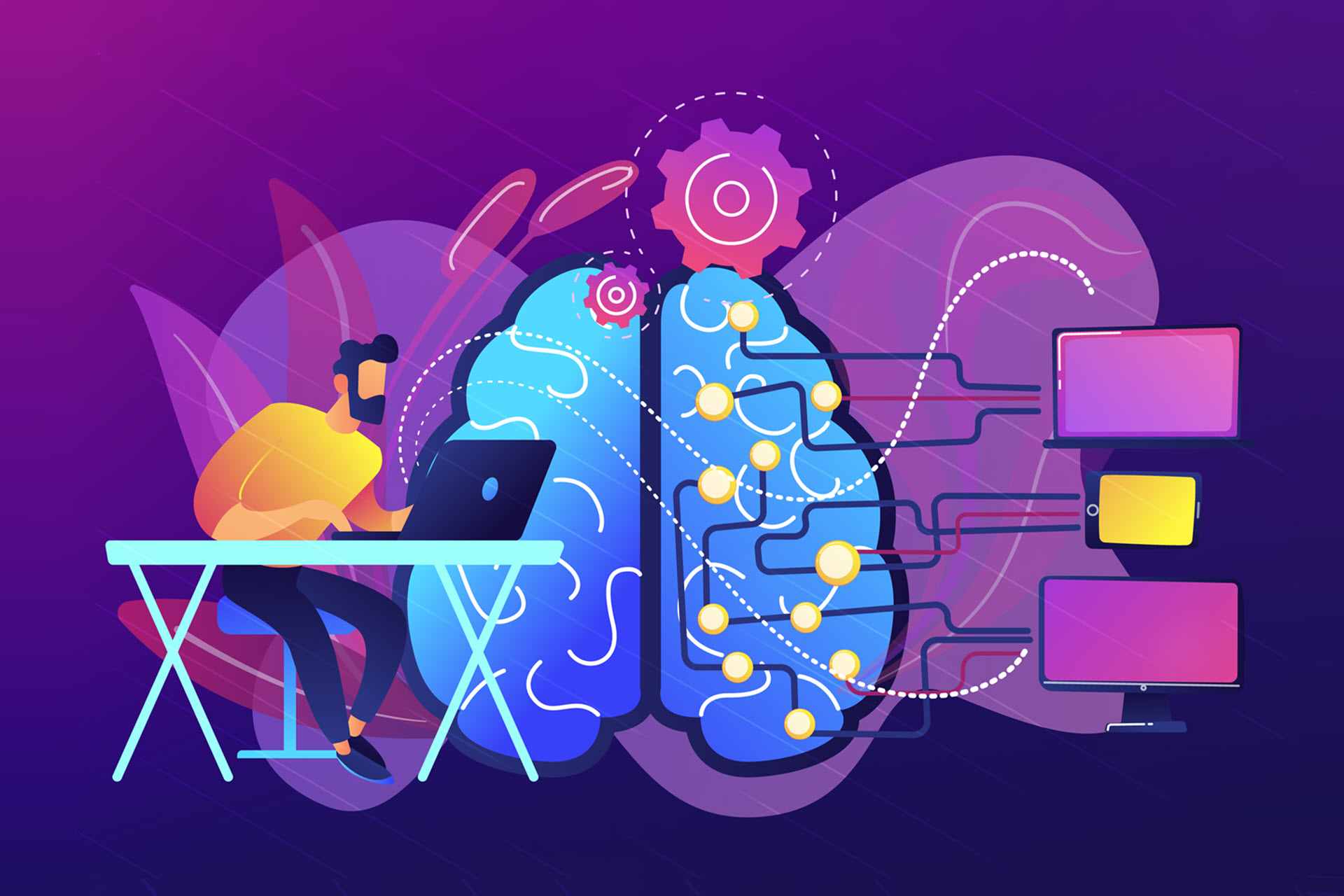Machine learning (ML) has made great strides in the last few years, and much of this growth is attributable to the availability of machine learning libraries. These libraries provide a variety of pre-built tools, algorithms, and components that make it easier to build and train ML models.
This article presents the top 14 machine learning libraries commonly used by developers working on ML projects. Jump in to see which libraries enable you to build ML models without writing massive amounts of code from scratch.

Only interested in Python-based ML libraries? Check out our article on Python machine learning libraries.
What Is a Machine Learning Library?
Machine learning libraries are collections of tools, functions, and pre-written code that developers use to simplify and speed up the creation of ML models. These libraries streamline the ML development process with various features and functionalities, such as:
- Tools to clean, transform, and prepare data for analysis.
- Various algorithms for classification, regression, clustering, and dimensionality reduction.
- Functions for training models and fine-tuning their parameters to improve accuracy.
- Tools to visualize data, model performance, and the learning process.
- General utilities for tasks like splitting data into training and testing sets, measuring performance metrics, and loading models.
Machine learning libraries offer considerable value to ML developers. Ready-made components and pre-written code significantly reduce development time, enabling teams to more easily experiment with different setups.
Libraries also make advanced machine learning techniques accessible to a broader audience, including those with limited ML or artificial intelligence (AI) expertise.
Developers aiming to maximize the benefits of ML libraries should have experience in multiple programming languages. Here's an overview of what languages ML developers most commonly use:
- Python is widely used due to its simplicity, code readability, and extensive range of available machine learning libraries.
- R is popular for statistical analysis and machine learning in research settings.
- Java and C++ are used for their performance-boosting advantages. These languages are valuable in production environments where speed and efficiency are critical.
- Julia is the go-to choice for numerical and scientific computing due to its high performance.
To become a top-tier AI developer, you'll have to learn how to write code in a few languages. Check out our article on the most popular AI programming languages to see which ones you should prioritize learning.
Best Machine Learning Libraries
There are hundreds of ML libraries to choose from, so finding the one that's right for your project is not always simple. Below are reviews of the 14 best machine learning libraries to speed up and streamline ML projects.
TensorFlow
TensorFlow is an open-source library that offers a rich ecosystem for building and deploying machine learning models. Developed by Google, this library is ideal for creating and deploying complex neural networks.

TensorFlow is one of the most popular machine learning frameworks due to its robust performance. The library supports eager execution, a mode that enables users to run operations immediately as they are called from Python. Eager execution is highly beneficial as it:
- Simplifies debugging.
- Makes development more intuitive.
- Enables efficient computations in large-scale ML tasks.
Here is what TensorFlow offers to ML developers:
- Building blocks for machine learning models, including a repository of pre-trained ML models.
- Tools for creating end-to-end machine learning workflows.
- Frameworks for model deployments (TensorFlow Lite and TensorFlow Serving).
- High-level APIs enable quick model building, while lower-level APIs allow for detailed customization.
- A repository (TensorFlow Hub) for reusable machine learning modules.
- Capabilities to deploy models on various platforms, including mobile devices, the web, and the cloud.
- A web-based visualization tool for model parameters, gradients, and performance.
- Tools for optimizing models for both training and inference.
TensorFlow is commonly used to develop neural networks, particularly deep learning (DL) models. TensorFlow is designed to run on multiple CPUs, GPUs, and TPUs, making it a versatile choice for various computing environments.
The library's extensive support for convolutional neural networks (CNNs) and recurrent neural networks (RNNs) makes it a preferred choice for computer vision and natural language processing (NLP) projects. Other common use cases for TensorFlow include predictive analytics, recommendation systems, and time-series forecasting.
Check out our article on deep learning frameworks to see what other options you have if TensorFlow does not look like an ideal fit for your DL project.
NumPy
NumPy is a Python-based scientific computing library. It provides powerful support for arrays, matrices, and various mathematical functions that enable numerical data manipulation.

As an open-source project, NumPy has become a key part of the scientific Python community, especially for projects that involve heavy matrix operations. The library's arrays (so-called NumPy arrays) perform vast matrix-based calculations in mere milliseconds.
Here is an overview of what NumPy offers to its users:
- Large, multi-dimensional arrays and matrices.
- Functions for reshaping, slicing, indexing, and merging NumPy arrays.
- Mathematical functions for trigonometric, statistical, and algebraic operations.
- Tools for generating random numbers and sampling from statistical distributions.
- Linear algebra operations, such as matrix multiplication and eigenvalue decomposition.
- Computation of fast Fourier transforms (FFT) and inverse FFTs.
- Functions to read from and write to files in various formats.
In the machine learning niche, NumPy is most commonly used for data manipulation and preprocessing. The library's array operations are optimized for performance, which is crucial when handling large data sets in machine learning tasks. NumPy is fully compatible with TensorFlow, PyTorch, SciPy, Matplotlib, and Pandas.
Pandas
Pandas is an open-source data analysis and manipulation library for Python. This library provides data structures and functions that ML developers often use to work with structured data, making it a go-to tool for data wrangling and analysis tasks.

Built on top of NumPy, Pandas is designed to handle data in various formats, including CSV, Excel, JSON, and SQL databases. The library's main selling point is that it reduces the effort required to perform complex calculations to just a few lines of code.
Pandas offers a comprehensive range of functionalities, including:
- Data structures for handling 1-dimensional (Series) and 2-dimensional data (DataFrame).
- Automatic alignment of data in operations.
- Functions for detecting and filling in missing data.
- Tools for merging, reshaping, and pivoting data sets.
- Utilities for filtering, sorting, and manipulating data.
- Functions to read from and write to various file formats.
- Methods to split data into groups, apply operations independently to each group, and then combine the results.
- Statistical functions for summarizing data.
ML experts commonly use Pandas for data preprocessing and feature engineering tasks. The library's robust data manipulation tools enable practitioners to clean and prepare raw data for input into an ML model.
Pandas' ability to perform complex aggregations and transformations makes it invaluable for exploratory data analysis (EDA). ML developers often use Pandas to detect patterns and insights in the data during EDA.
Scikit-Learn
Scikit-learn is an open-source machine learning library for Python. Built on NumPy, SciPy, and Matplotlib, this library offers simple and efficient tools for data mining and in-depth analysis.

Scikit-learn's accessibility and high levels of reusability make it a popular choice for both ML research and enterprise applications. The library makes it simple to implement and experiment with both supervised and unsupervised machine learning approaches.
Here's what Scikit-learn offers to machine learning developers:
- Tools for supervised learning tasks (support vector machines (SVM), logistic regression, decision trees).
- Methods for predicting continuous outputs, including linear, Ridge, and Lasso regression.
- Techniques for unsupervised learning, including k-means, hierarchical clustering, and DBSCAN.
- Tools for reducing the number of features in the data, such as Principal Component Analysis (PCA) and Linear Discriminant Analysis (LDA).
- Functions for cross-validation, grid search, and performance metrics.
- Utilities for feature scaling, selection, normalization, encoding categorical features, and handling missing values.
- Tools for creating workflows that streamline the preprocessing and modeling process.
Scikit-learn is commonly used to build and evaluate the performance of predictive ML models. The library's vast array of algorithms makes it ideal for everything from simple linear regression to complex ensemble methods.
Our in-depth guide to regression algorithms explains the different types of algorithms (all written with the help of Scikit-learn) that enable ML models to make data-driven predictions.
Matplotlib
Matplotlib is an open-source plotting library for Python. ML developers often use Matplotlib to create static, animated, and interactive visualizations of the performance of deployed ML models.

Matplotlib offers a wide range of functionalities, including the following capabilities:
- Support for line plots, scatter plots, bar charts, histograms, pie charts, etc.
- Various customization options for plot appearance, including colors, labels, and markers.
- Tools for creating complex multi-plot layouts.
- Capabilities for zooming, panning, and updating plots in real-time.
- A three-dimensional plotting toolkit.
- Tools for creating animated plots to visualize model changes over time.
Machine learning developers use Matplotlib to create various plot types that help them understand:
- Data distributions.
- Relationships between variables.
- The results of machine learning models.
Visualizing model metrics, feature importances, and prediction results allows users to gain deeper insights into models and communicate their findings more effectively.
PyTorch
PyTorch is an open-source machine learning library developed by Facebook's AI Research lab. This library is a go-to choice for creating deep learning applications as it provides a flexible platform for building and training deep neural networks (DNNs).

One of PyTorch's main selling points is its dynamic computational graph, which allows for more intuitive and flexible model development. The library's support for GPU acceleration is another key reason it is so popular in the AI and ML niche.
Here's an overview of what this machine learning library offers to developers:
- Dynamic computational graphs for model building and debugging.
- Support for multi-dimensional arrays and numerous mathematical operations.
- Utilization of CUDA-enabled GPUs for faster computation.
- Automatic differentiation for gradient computation, a feature that simplifies backpropagation during model training.
- Various optimization algorithms (SGD, Adam, RMSprop, etc.).
- A wide range of pre-defined loss functions for training neural networks.
- Tools for loading, preprocessing, and augmenting data.
PyTorch's primary ML use case is developing and experimenting with deep learning models. The library's dynamic computational graph allows developers to modify and test models on the fly, making PyTorch ideal for rapid prototyping.
PyTorch's extensive support for neural network components and GPU acceleration also makes the library an excellent fit for training complex models on large data sets.
Our PyTorch vs. TensorFlow comparison offers an in-depth look at the differences between these two highly popular ML libraries.
Statsmodels
Statsmodels is an open-source Python library for statistical modeling. This library complements frameworks like NumPy, SciPy, and Pandas by providing additional statistical analysis capabilities.

Statsmodels provides tools for estimating and testing statistical models, so users often use this library to explore data, perform tests, and estimate model performance. Here is a list of the main features and capabilities offered by Statsmodels:
- Ordinary Least Squares (OLS) and Generalized Least Squares (GLS) linear models.
- Generalized linear models for logistic regression, Poisson regression, and other link functions.
- Tools for ARIMA, SARIMAX, and state space models.
- Functions for analyzing time-to-event data.
- Various statistical tests (t-tests, chi-square tests, ANOVA).
- Descriptive statistics for summarizing and exploring data.
- Methods for dealing with outliers in data.
- Mixed linear models for analyzing data with both fixed and random effects.
Machine learning developers use Statsmodels for statistical analysis and hypothesis testing. The library's classical statistical techniques allow you to quickly validate assumptions, test hypotheses, and derive insights from data.
Keras
Keras is a user-friendly and highly modular Python-based deep learning library. It serves as an interface for the TensorFlow library and helps simplify the process of building and training complex neural networks.

Keras allows users to prototype deep learning models quickly without necessitating extensive knowledge of the underlying mathematics. Let's look at what Keras offers to machine learning experts:
- A high-level neural network API that enables you to build and train neural networks with minimal code.
- A variety of pre-defined and custom components for creating complex models.
- Access to pre-trained models.
- Functions for image, text, and sequence data preprocessing.
- Tools for monitoring and adjusting training processes, such as early stopping and learning rate scheduling.
- Ability to fully customize layers, models, and loss functions.
ML and AI developers use Keras for rapid prototyping and experimentation with deep learning models. The library's intuitive interface allows developers to design and test new ideas quickly.
Keras is also widely used in production environments due to its ability to scale and integrate with TensorFlow. The TensorFlow integration makes Keras suitable for deploying deep learning models in various applications, from computer vision and NLP to time series analysis and reinforcement learning.
OpenNN
OpenNN is an open-source C++ library that helps users develop and train neural networks. This library provides various tools for advanced analytics and is commonly used both for ML research and commercial applications.

OpenNN focuses primarily on scalability and speed. The library's robust architecture allows users to quickly implement complex neural networks and perform detailed analyses during training and deployment.
Here is what you get from the OpenNN library:
- Tools for building and configuring various types of neural networks.
- Support for multiple activation functions, including sigmoid, hyperbolic tangent, and rectified linear units (ReLU).
- A variety of training methods (gradient descent, quasi-Newton, evolutionary algorithms, etc.).
- Various loss functions for regression and classification tasks.
- Techniques for validating and testing neural networks.
- Tools for managing and preprocessing data, including normalization and splitting data sets.
- Functions for visualizing network architectures, training progress, and performance metrics.
Machine learning experts commonly use OpenNN to develop advanced predictive models, often in fields such as finance, energy, and healthcare. The library's parallel execution enables it to handle large data sets and perform complex calculations efficiently.
OpenNN is also a popular library choice in research environments when experts want to test new neural network architectures and training algorithms.
Shogun
Shogun is an open-source machine learning library that offers a wide range of ML algorithms. Written in C++, this library provides interfaces for several programming languages, including Python, Java, and R.

Shogun supports a variety of machine learning tasks, including classification, regression, clustering, and dimensionality reduction. An emphasis on scalability and performance makes the library suitable for large-scale data analysis and research applications.
Here's an overview of what you will find in this machine learning library:
- A variety of classification (SVM, k-nearest neighbors, linear discriminant analysis) and regression algorithms (linear regression, Gaussian process regression, kernel ridge regression).
- Clustering techniques like k-means, hierarchical clustering, and spectral clustering.
- Dimensionality reduction algorithms, including PCA and Independent Component Analysis (ICA).
- A wide variety of kernel functions for use in SVMs and other algorithms.
- Ensemble methods and techniques like random forests and boosting.
- Tools for identifying the most relevant features in data.
- Functions for cross-validation, performance metrics, and statistical testing.
ML specialists primarily use Shogun to explore and develop new ML algorithms. The library's extensive range of algorithms and flexibility make it a popular choice for those aiming to test new approaches to machine learning problems.
Read our comparison of R and Python, two popular programming languages in data science, visualization, and data analysis.
Jax
JAX is an open-source numerical computation library developed by the Google Research team. This library provides high-performance computing capabilities and is a fine fit for both ML research and commercial development.

JAX transforms numerical functions into highly efficient, compiled code that can run on both CPUs and GPUs. The library also offers automatic differentiation, a technique used in ML and scientific computing to efficiently and accurately compute the derivatives of functions. Automatic differentiation makes JAX highly useful for optimization tasks in deep learning.
JAX offers a comprehensive range of functionalities, including:
- Efficient gradient computation for complex functions.
- Just-in-time (JIT) compilation that transforms and optimizes Python code for fast execution on CPUs and GPUs.
- Automatic vectorization of code.
- Tools for parallel computation across multiple devices.
- Advanced random number generation for stochastic processes.
- Tools for handling and computing with sparse matrices.
- Integration with other machine learning libraries, including TensorFlow and PyTorch.
JAX is commonly used to develop and optimize deep learning models and algorithms. Automatic differentiation and JIT compilation allow ML experts to experiment with and fine-tune complex models.
Caffe
Caffe is an open-source deep learning framework designed with speed and extensibility in mind.

This library supports various types of deep learning architectures geared towards image classification, segmentation, and other visual recognition tasks. Caffe can process over 60 million images per day with a single NVIDIA K40 GPU.
Here is an overview of everything Caffe offers:
- A highly modular architecture that allows users to define and customize deep learning models using a simple configuration file.
- Support for both CPU and GPU computation.
- Access to the Model Zoo, a collection of pre-trained models for various tasks.
- Flexibility to build and modify network layers without altering the core code.
- Integration APIs for Python and MATLAB environments.
- Tools for managing and preprocessing large data sets.
- Built-in tools for visualizing training progress and model architecture.
Machine learning specialists often use Caffe to develop and deploy convolutional neural networks for image recognition and classification tasks. Caffe's speed and efficiency make it particularly well-suited for applications that require real-time processing, such as autonomous driving and video surveillance.
ML.NET
ML.NET is Microsoft's open-source machine learning framework for the .NET ecosystem. This library enables developers to build custom machine learning models and integrate them into .NET applications using a familiar programming environment.

ML.NET is highly user-friendly and versatile. It supports a wide range of machine learning tasks, including classification, regression, and clustering. Here's an overview of ML.NET's functionalities:
- Tools for creating and training machine learning models with a range of algorithms.
- Utilities for data loading, transformation, and normalization.
- Functions for assessing model performance using metrics like accuracy, precision, and recall.
- Tools for building and fine-tuning machine learning pipelines.
- A variety of pre-trained models for sentiment analysis and image classification tasks.
- Tools for automating the process of model selection and hyperparameter tuning.
ML.NET is a common choice in enterprise ML environments where .NET is the primary technology stack. ML.NET's support for various machine learning tasks makes it a valuable tool for users looking to enhance .NET applications with advanced analytics and predictive capabilities.
Deeplearning4j (DL4J)
Deeplearning4j is an open-source library for the Java Virtual Machine (JVM). It provides a robust platform for building and deploying deep learning models. Developed by Skymind, DL4J integrates seamlessly with Java-based applications and supports a wide range of deep learning architectures.

DL4J offers a comprehensive set of tools for developing neural networks. Its ability to run on both CPUs and GPUs makes it highly suitable for high-performance machine learning tasks. Here is what DL4J offers to ML developers:
- Tools for building and configuring deep learning models with various architectures.
- Support for optimization and training algorithms, including stochastic gradient descent and Adam.
- Access to pre-trained models available for transfer learning.
- Tools for data augmentation.
- Capabilities for visualizing network architectures and training progress.
- APIs for integrating deep learning models into Java and Scala applications.
Machine learning developers commonly use DL4J to build enterprise-level applications that require deep learning capabilities within the Java ecosystem. The native integration with JVM makes DL4J particularly valuable for businesses that rely on Java as their primary technology stack.
Additionally, Deeplearning4j is frequently used in big data environments where integration with Hadoop and Spark is essential.
While revolutionary, AI is far from a risk-free technology. Check out our article on artificial intelligence risks to see the most notable dangers of AI technologies.
How to Choose the Best Library for Machine Learning?
Selecting the ideal library for your machine learning project can be challenging, as many offer similar functionalities. Here's what you should consider when choosing a library:
- Ensure the library supports the algorithms you need for your project.
- Assess the ease of learning and using the library, particularly for teams with limited experience in machine learning libraries.
- Evaluate the library's performance in terms of training and inference speed, especially if you have large data sets and complex models.
- Ensure the library allows you to customize algorithms and workflows to fit your specific needs.
- Choose a library that is compatible with the programming language you are using.
- Consider how well the library integrates with other tools and libraries you are using.
- Ensure the library can handle your data set size and scale with your project's growth.
- Consider the potential costs of using the library, including potential commercial licenses and implementation expenses.
Once you've narrowed the list of potential options, create a shortlist of libraries that meet your needs. Then, implement a small, representative part of your project using each shortlisted library. This hands-on approach will give you practical insights into each library's strengths and weaknesses.
Compare the performance, ease of use, and integration capabilities of each library based on the results of pilot projects. Choose the library (or libraries) that best suit your project requirements, development environment, and long-term goals.
There Is Zero Need to Write ML Code from Scratch
Machine learning is complex, but it becomes nightmarishly difficult and time-consuming if you write every single line of code from scratch. Use what you learned here to ensure your team is not needlessly wasting time on writing code that is readily available in one of the machine learning libraries covered in this article.



